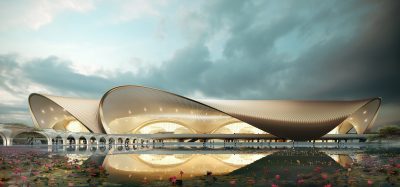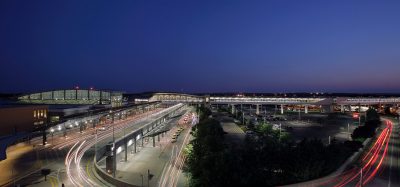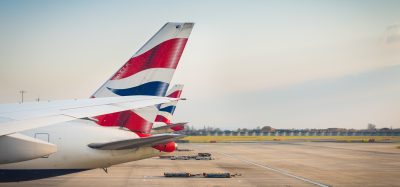Air rail intermodality – an overview
Posted: 7 June 2007 | Andrew Sharp, Director General, International Air-Rail Organisation | No comments yet
A rail connection is a real bonus to an airport. About 120 of the world’s airports have one or more rail links today: a further 300 are building them, planning them or considering them. While there are no clear definitions or boundaries, five different types of passenger rail connections to airports can be distinguished. Rail connections handling cargo are dealt with under a separate sub heading.
A rail connection is a real bonus to an airport. About 120 of the world’s airports have one or more rail links today: a further 300 are building them, planning them or considering them. While there are no clear definitions or boundaries, five different types of passenger rail connections to airports can be distinguished. Rail connections handling cargo are dealt with under a separate sub heading.
Light rail is an efficient means of airport access. It can be seen on the east and west coasts of the USA (in Portland, Oregon, and at Baltimore Washington International Airport on Maryland) and in Europe (in Porto and Bremen).
It is not usually of the highest quality, but the new Leslys high speed tram between Lyon and Lyon St-Exupéry airport will be worth watching. It will only stop at two key interchanges between city and airport, and will use special tracks to overtake the all-stations trams with which it will share part of the route.
Light rail is cheaper and easier to build. It can tolerate steeper gradients and tighter curves than heavy rail and is therefore easier to fit into an urban environment. Because of its good in-town distribution, it is particularly good for employee transport. Two new examples under construction in Europe, in Copenhagen and Manchester, will serve areas of high unemployment on their way to the airport, performing a valuable social service as well as enlarging and diversifying the airport’s labour pool.
Suburban and metro services, as seen in Singapore, Brisbane and Sydney and under construction in Kaohsiung and Beijing, are the most common type of airport railway. They too are particularly good for carrying employees. This is important because around a third of all airport access trips are by employees (for each million passengers through an airport each year, there are around 1000 airport-based employees making 10 trips a week, 50 weeks a year). The reputation of an airport depends to a large degree on people like cleaners, retail and catering staff and baggage handlers who are not particularly well paid. They need an alternative to driving and especially to the high costs of buying, licensing, taxing and insuring a car in the first place.
Airport employees tend to have low car occupancy and to be unwilling to pay for parking: they contribute to road congestion and land-use around the airport without offsetting car park revenue.
Regional rail can expand an airport’s catchment area.
Good examples are in Manchester, in the UK, where rail’s mode share from places like Leeds and York is higher than from Manchester itself; and Leipzig-Halle, in Germany, where rail is being used as a weapon in the fight for traffic with the airports of Hanover and Berlin. The airport authority has funded a moonlight check-in facility at Magdeburg station, equidistant between the three airports. Passengers pay €10 to check-in there – and they do so. It has a real impact on mode choice and choice of airport.
Continental Airlines uses regional rail on the US Northeast Corridor to expand its network and to free up slots. When a new station opened at Newark airport, it withdrew its seven daily flights between Newark and Philadelphia in favour of a code-share with Amtrak; and at the same time started code-shares to New Haven and Stamford (Connecticut) and Wilmington (Delaware) – places it had never flown to.
There are some particularly good examples of high quality Airport Expresses in Asia-Pacific. KLIA Ekspres, serving the Malaysian capital’s stunning airport at Serpang, is highly innovative. It is one of the few airport railways to have developed facilities to check-in bags at the downtown terminal. It is unique among Airport Expresses in planning the reverse. From November, it should be possible to check bags from your airport of origin to Kuala Lumpur Sentral Station in downtown Kuala Lumpur. And when visiting the city, KLIA Ekspres’s VIP service is highly recommended, although you have to pre-book. With this service, you are met at the airport as you come out of immigration: you are guided to baggage reclaim and you and your bags are taken down to the train. At Sentral station, you are escorted up to a desk where a limousine driver greets you and takes you to your hotel or office.
Airport Express Hong Kong, which also has in-town check-in, shows excellence in a number of areas. One of these is finance. The company uses property development along the route to fund part of its capital expenditure, so the railway benefits from the enhanced value of the land created by the presence of the railway, which seems fair and reasonable. The residents in apartments near stations like Tsing Yi and Olympic benefit from real transit-oriented development, and find an easy commute into the city or ride out to the airport.
The third Asia-Pacific example is Shanghai’s maglev (magnetically levitated train), serving Pudong airport and being extended to the domestic airport at Hongqiao. It reaches a top speed of 432 km/h between city and airport. It is very difficult to draw conclusions from Shanghai – the system was built incredibly fast, with Chinese labour, on ground which is essentially river alluvium (so a feature of the design is that the columns periodically have to be jacked up to keep the guideway level). All of these factors will have affected the cost of the system and made it difficult to compare with other possible applications of the technology.
The final type of airport railway is the airport station on the high speed rail network. These currently only exist in Europe. Airports like Paris Charles de Gaulle, Lyon St-Exupéry, Frankfurt, Köln and Düsseldorf have stations on the high speed rail network and benefit from having them.
About a dozen airlines code-share with SNCF (French Railways) between Paris Charles de Gaulle airport and about a dozen domestic destinations in France as well as Brussels. There is only one flight a day between Paris and Brussels, operated by the Belgian airline Brussels Airlines: the rest are air-rail code-shares between Air France and SNCF. The scheme started for environmental and economic reasons.
The train service was so good that all city to city passengers were using it anyway, so the only people flying were those who were interlining at Paris Charles de Gaulle. This was uneconomic, and there is a train station at the airport, so the code share with the high speed train operator made sense. Air France use it to bolster their environmental credentials and their passengers love it: there’s more leg-room, more space, better views, more freedom to move around and less hassle (especially at check-in).
If you fly from Singapore to Stuttgart, you are likely to have to change at Frankfurt – and if you fly on a Star Alliance carrier, you will probably change between plane and train there. You will have an integrated ticket, with boarding passes for the flight and for the train and your bags will be checked through to the station in downtown Stuttgart where you will collect them from an ordinary baggage reclaim belt before passing through German Customs. The minimum connection time between plane and train is 45 minutes, the same as between plane and plane.
Malaysia is considering a high speed rail link between Kuala Lumpur and Singapore: this would serve Kuala Lumpur International Airport. The new service would probably be operated by the same people as the Airport Express, the fastest train in south-east Asia. It would certainly be better environmentally than the current 15 daily flights on this 315 km segment. Over that kind of distance, over a quarter of the aircraft’s fuel is consumed in just taking off and landing.
An objection sometimes made by airport operators to railways is that they reduce parking revenue. Possibly true, but airports can earn more from retail and commercial business than from parking. Recent figures from BAA show that the retail income per passenger at its UK airports was three times the parking revenue per passenger – and, unlike parking revenue, growing. Retail and commercial revenue tends to be largely profit, whereas car parks need to be staffed, cleaned, lit and policed (and built in the first place – a new parking structure at New York JFK is to cost nearly $50,000 per space).
Air rail cargo
Rail is used to transport three different kinds of cargo to and from airports – building materials, fuel and air freight.
Most airports are construction sites, and a lot of high bulk low value materials are used for building work – or are a by-product of it. They are natural traffic for rail. Dedicated rail terminals were built for both Manchester’s second runway and Heathrow’s Terminal 5 (to open at the end of March). Large quantities of stone, sand, steel and cement were brought in by rail, keeping numerous lorry trips off sensitive or congested roads (the cement for Terminal 5, for example, came from Lincolnshire, 200 kilometres away).
One nice example of synergy can be found in Stockholm. The airport authority was allowed to build a third runway only if it facilitated construction of a high speed rail link. Rock excavated from the rail tunnels under the airport was used as foundations for the runway.
Oslo’s airport is served by a daily fuel train, rather than 50 road tankers a day on the 50 km between docks and airport. Environmental reasons were as compelling as the economics. When the terminal formerly used for Stockholm Arlanda airport’s fuel was to be closed, a full investigation of the alternative ports, modes and routings was made. Pipelines have a high capital cost, a low operating cost and a high degree of inflexibility: railways have a lower capital cost, higher operating costs and more flexibility for varying volumes, origins and destinations. The best option turned out to be importing the fuel through the port of Gävle, 140 km north of the airport, and bringing it from there by rail to a railhead just to the west of the airport.
Two airports are investigating the use of rail for air cargo, although there are others – notably Huntsville, Alabama and Alliance, Texas – where air, rail and road meet: at these, there tends to be processing of cargo brought in on one mode before it goes out on another, rather than true air-rail intermodality.
Leipzig-Halle, in eastern Germany, is DHL’s new European hub: plans are being made to serve it by a network of high speed rail shuttles from 6 major cities. The shuttle trains, which will be purpose built to carry both ISO and 747 main deck containers using roller-bed technology, will be able to get from places like Frankfurt, Hamburg, Kassel and the Ruhr to Leipzig-Halle airport in 3 hours or less using the high speed rail network.
Paris Charles de Gaulle plans two air-rail cargo interchanges at the airport – one to the west, mainly for mail (the French postal authority La Poste already owns 3? TGV – high speed train – sets), and one to the south, mainly for air cargo. The CAREX project has high level support from the French government, local authorities and the European Union. Air cargo trains will radiate from the airport to key points like London, Brussels, Lyon, Marseille and Bordeaux.
Both projects have real potential, and these are being taken forward by far-sighted airports.
Andrew Sharp
Mr. Sharp has over 30 years experience in the transportation industry – mainly the rail industry in the UK. He is currently Director-General of the International Air Rail Organisation, a world-wide group of organisations across the air and rail industry with an interest in rail links to airports.
He has undertaken consultancy work for a number of companies interested in airport rail connections, and has also been retained by Heathrow Express as a consultant.
He has a Masters degree in Transportation and Traffic Planning from the University of Birmingham, and is a Member of the Chartered Institute of Logistics and Transport.
He is a member of the Transportation Research Board’s Committee on Intermodal Transfer Facilities, and the Aviation Forum of the Chartered Institute of Logistics and Transport.
He is married with two children, and lives in St. Albans, the historic city 20 miles north of London where he was born.
New report from International Airport Review: Securing Airports in an Evolving Threat Landscape
International Airport Review has brought together top voices from across the global aviation security sector, including International Civil Aviation Organization (ICAO), ACI World, Fraport, Qatar Civil Aviation Authority, Winnipeg Airports Authority, and Smiths Detection to examine today’s most pressing airport security challenges and emerging threats.
This expert-led report provides a strategic assessment of the vulnerabilities facing airports in 2025, encompassing cyber-attacks, drone incursions, evolving geopolitical risks, and emerging technologies.
The result is a practical, insightful guide to strengthening airport resilience, anticipating risks before they escalate, and keeping your airport off the front page
Download the report for free and stay ahead of the security curve – READ FOR FREE NOW!

















